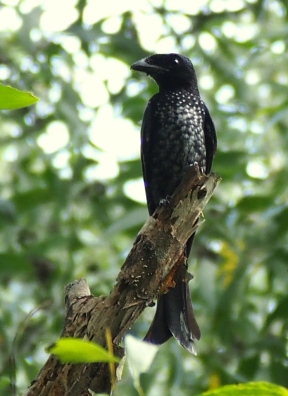

White-winged Terns, ( 20-24 cm), juvenile on the right.
It is the smaller of the two “Marsh” (Chlidonias) Terns, the other being the Whiskered Tern. It is about the same size as the Lttle Tern but does not have the fork tail. Best ID feature is the “headphones” on both side of the face. It also has a white rump and smaller bill. Prefers inland fresh water bodies like Serangoon reservoir. Skims over the surface to pick up its catch.


Little Tern (22-25 cm), breeding on the left and non-breeding on the right.
Black cap and nape during breeding, white from forehead to behind the eyes. Strong yellow bill with black tip and yellow legs. Harder to separate in non breeding plumage. Look for the deep fork tail and long, thick lighter colored bill. Often looks down when flying over water, it plunges straight down to catch its food. Flies near the shore off Changi and Labrador.


Whiskered Tern ( 24-28 cm)
Very similar in appearance to the White-winged Tern but larger. Can be separated from White-winged by thicker and longer bill and grey rump. Also lacking the dark patch “headphones” below the eyes which can be hard to tell apart in the field. Also skims along the surface for food. Shares same fresh water habitats with White-winged. Kranji and Serangoon Reservoirs.

Now can you separate these “Marsh” Terns perched on the railings at Kranji Reservoir?

Black-naped Terns ( 30-35 cm)
Medium size, very white in appearance with a dark band from lore to the black of the nape. Long deeply forked tail. Many terns of the same size in their non-breeding plumage have very similar markings, so care need for identification. Small breeding colony in the Straits of Johor.


Aleutian Tern ( 32-34 cm) breeding plumage on the left.
Once thought to be vagrant to our waters, we now know that a small population winters and passes through the Straits of Singapore during the migratory months. Grey upperparts contrast with white rump. In flight, look for the dark trailing edges of the secondaries. White forehead and black from crown to nape during breeding. Often seen resting on floating debris.


Common Tern ( 33-37 cm)
Uncommon winter visitor, this medium tern has long forked tail. The outer edges of the primaries are dark. At rest, the wings and the tail is of the same length. Non breeding plumage: White forehead and black crown and nape. Straits of Singapore and sometimes inshore.


Gull-billed Tern ( 34-37 cm) Breeding plumage left, non-breeding right.
A rare winter visitor and passage migrant, this heavy bodied tern is best identified by its thick black bill. In flight the broad wings are white below with dark outer primaries. Full black cap during breeding. Small black patch on ear coverts during non breeding. Does not plunge from the air. Reported at inshore waters near the coast at old Halus ponds and Serangoon Estuary.


Lesser Crested Tern ( 35-40 cm) 2nd from the right in breeding plumage, rest non breeding.
Best separated from Swift tern by slightly smaller size and orange bill. During breeding, lacks white forehead as the black crown extends from nape to front. The white on its head is more extensive than Swift tern during non breeding. Prefers off shore waters at Straits of Singapore and Johor.


Bridled Tern ( 37-42 cm) breeding.
An uncommon winter visitor, this large tern may have a small breeding population at Horsburgh Lighthouse. Separated from the Aleutian Tern by a total slaty grey upper part including the rump. The white supercilium extends beyond the eyes. Eastern Straits of Singapore near Pedra Branca.


Swift Tern ( 45-49 cm) breeding on the right.
This large tern has a thick slightly decurved yellow bill. It has a black cap, white forehead and a shaggy crest. Easily identified by its size both in flight and perched. Found with Lesser Crested Terns offshore waters of Straits of Singapore and Johor.
Reference: A field Guide to the Waterbirds of Asia. Wild Bird Society of Japan 1993. A field Guide to the Birds of Thailand and South East Asia. Craig Robson 2000. The Avifauna of Singapore. Lim Kim Seng 2009.
Photo Credits: Alan OwYong, Francis Yap and Jimmy Chew.































 e
e













